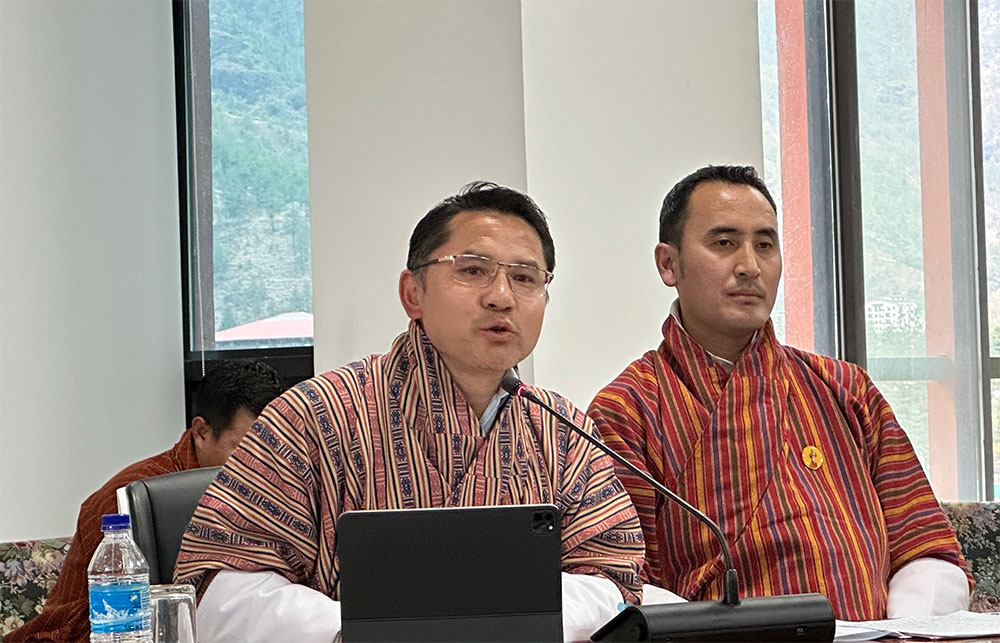YK Poudel
To enhance the agriculture sector’s role in contributing to the Gross Domestic Product (GDP), the Ministry of Agriculture and Livestock (MoAL) plans to prioritise high-tech farming in the 13th Plan.
During the second session of meet-the-press last Friday, Agriculture and Livestock Minister, Younten Phuntsho talked about the objective of doubling the country’s GDP from USD 2.5 billion to USD 5 billion by 2029. “By 2034, Bhutan aims to achieve a high-income status with an economy valued at USD 10 billion.”
Food and Nutrition Security Policy, 2023, projects that by 2034, the agriculture and livestock sector will be tasked with feeding approximately 837,288 people. This entails producing about 289,748 metric tonnes (MT) of cereals, 140,160 MT of vegetables, 82,202 MT of milk, 5,003 MT of meat, among other essential food items.
Over the years, agricultural production in Bhutan has witnessed a decline. In 2022, the nation produced 70,168 MT of primary cereals. This decline can be attributed to various challenges, including issues related to landholding, limited access to financial resources for agricultural activities, adverse effects of climate change, insufficient water supply for irrigation, and difficulties in post-harvest management.
“The ministry aims to achieve a GDP contribution of Nu 50 billion by 2029, in line with the government’s vision for economic prosperity,” the minister said.
Introducing Hi-tech Chirub farms, the minister said, is one of the many strategies planned by the agriculture department to enhance production. “These advanced farms will leverage cutting-edge technology to optimise efficiency and productivity.”
The ministry is advocating for integration among key agricultural agencies.
“Our approach involves collaboration with Farm Machinery Corporation Limited (FMCL), government agencies, youth and de-suups,” the minister said.
The ministry will strengthen the use of resources, expertise, and proven technology to enhance capacity building among farmers.
The minister credited the national service for incorporating food security—agricultural technology, protected agriculture, and drip agriculture into its programmes to teach youths how to efficiently use scarce resources.
Key strategies include a collaborative approach, exemplified by the Hi-tech Chirub Farm, which will involve the combined efforts of various stakeholders, leveraging their expertise and resources.
The use of proven technology mitigates the risk of technological failure.
By engaging youth and adults at an early stage, capacity building across the entire value chain is ensured, fostering a sense of ownership and commitment.
“The government will offer policy oversight, technical expertise, and initial investment mobilisation to bolster the success of the venture. Initially focusing on priority commodities with guaranteed markets within the country, such as schools and institutes, enhances the likelihood of success. Integrating technology and machinery makes farming more appealing and accessible to both youth and adults, thereby increasing the prospects of success,” the minister said.
Recognising the demand for better markets, Bhutan has already commenced exporting high-value commodities to neighboring countries such as Japan, Singapore, Thailand, and the Middle East.
The 13th Plan places an emphasis on the commercial production of high-value organic agricultural commodities. These include asparagus, broccoli, quinoa, strawberry, cauliflower, buckwheat, and adzuki beans.
Furthermore, the Plan proposes the production of new high-value livestock commodities, including rainbow trout, sturgeon caviar, yak cheese and fiber, putka and comba honey, yagyu cheese, and royal jelly.
Under the agriculture department’s support, farming communities have been connected to schools, hospitals, and Gyalsung Academies, where farmers can supply their produce at an anticipated rate.
The ministry is implementing strategic measures concentrating on farm mechanisation, irrigation, and the cultivation of high-value crops, the minister said.
Bhutan possesses approximately 8 percent, or 277,000 acres, of arable land. Only a fraction of this land, roughly 23 percent, is being cultivated.


